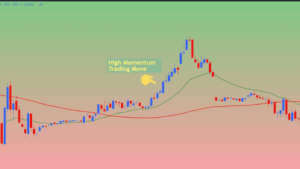Learn the Momentum Trading Strategies : Trend Following
Momentum trading is a powerful strategy that focuses on taking advantage of short-term trends in the stock market. By capitalizing on the strength and persistence of price movements, momentum traders aim to ride the wave of upward or downward momentum for quick profits.
- In this article, I will guide you through the key concepts of momentum trading and show you how to harness its potential for success.
- We’ll explore the role of technical analysis, trend-following strategies, algorithmic trading, and price action in momentum trading. Additionally, I’ll discuss effective risk management techniques to safeguard your investments.
Whether you’re new to trading or an experienced investor looking to enhance your skills, mastering momentum trading strategies can give you a competitive edge in the stock market.
So, let’s dive in and discover how you can leverage momentum trading to achieve your financial goals.
Important Details :
- Momentum trading is a strategy that aims to capitalize on short-term trends in the stock market.
- Finding possible entry and exit points for trades is a critical function of technical analysis.
- Trend-following strategies, such as moving averages and breakout trading, can maximize profits in momentum trading.
- Algorithmic trading can enhance the speed and accuracy of executing trades based on predefined criteria.
- Price action provides valuable insights for making informed trading decisions in momentum trading.
Understanding Momentum Trading :
Momentum trading and its operation will be explained in this section. We’ll discuss trading based on price strength and persistence to capitalize on short-term stock market trends.
- Momentum trading targets assets with significant up- or down-trends. This trading method capitalizes on short-term trends and price swings to make money.
- Momentum traders hunt for stocks or other financial assets with large price fluctuations in one direction.
- This approach assumes market movements will continue in the same direction, allowing traders to profit on momentum.
Successful momentum trading requires finding stocks or assets with significant and consistent price movement. These possibilities are often found by traders using technical analysis.
- By evaluating price charts, patterns, and indications, traders can identify equities that will likely continue their uptrend or downtrend.
- A typical momentum trading approach is trend following. This strategy involves trading the trend.
- Traders want equities with higher highs and lower lows in uptrends or downtrends.
Breakout trading occurs when a stock price breaks free of critical support or resistance. Traders think a stock breaking these levels signals a momentum spike and a good trading opportunity.
- Day traders and other short-term traders who seek to profit from transient market changes sometimes choose momentum trading. It takes quick decision-making and action to seize possibilities.
- However, momentum trading is risky. Stocks can quickly reverse their uptrends. Thus, momentum trading requires risk control.
- Momentum trading in the stock market lets traders profit on short-term trends and price swings. However, it involves thorough analysis, swift decision-making, and risk management.”
The Role of Technical Analysis in Momentum Trading :
In the dynamic world of momentum trading, technical analysis plays a crucial role in identifying profitable opportunities and crafting effective trading strategies.
- By analyzing price charts, patterns, and indicators, traders can gain valuable insights into market trends, potential entry and exit points, and overall market sentiment.
- Technical analysis involves studying historical price data and using various tools and techniques to interpret market behavior. It enables traders to make informed decisions based on market patterns and the principles of supply and demand.
By understanding the underlying dynamics of price movements, traders can effectively gauge market trends and identify potential momentum opportunities.
Analyzing Price Charts :
Price charts serve as the foundation for technical analysis in momentum trading. They depict the historical price movements of a security, such as a stock or a currency pair, over a specific period of time.
- Traders analyze these charts to identify patterns, trends, and important price levels that can indicate potential trading opportunities.
- Chart patterns, such as support and resistance levels, trend lines, and chart formations like head and shoulders or double tops/bottoms, provide valuable insights into the ongoing market sentiment and the balance between buyers and sellers.
By recognizing these patterns, traders can make more accurate predictions of future price movements and adjust their trading strategies accordingly.
Using Technical Indicators
Technical indicators are mathematical calculations applied to price and volume data to further enhance the analysis in momentum trading. These indicators help traders identify overbought or oversold conditions, trend strength, momentum, and potential trend reversals.
- Commonly used technical indicators in momentum trading include moving averages, relative strength index (RSI), stochastic oscillator, and MACD (Moving Average Convergence Divergence).
- Traders incorporate these indicators into their analysis to confirm or contrast their observations from price charts and gain additional insights into the market.
- For example, moving averages help identify the direction of the trend and potential support or resistance levels.
- RSI and stochastic oscillator indicate overbought or oversold conditions, indicating potential reversal points. MACD reveals changes in momentum and generates buy or sell signals.
“Technical analysis is like a compass that guides traders through the complex maze of the market. It helps to objectively analyze price movements, identify potential trading opportunities, and manage risk effectively.”
By combining chart patterns, technical indicators, and market analysis, traders can develop robust momentum trading strategies. Technical analysis serves as a valuable tool in understanding market dynamics and making informed decisions to capitalize on short-term trends and maximize trading profits.
Trend Following Strategies for Momentum Trading
When it comes to maximizing profits in momentum trading, trend-following strategies are key.
- By identifying and capitalizing on prevailing market trends, traders can ride the wave of momentum for increased profitability.
- In this section, I will delve into various trend-following techniques commonly used in momentum trading, including moving averages, trend lines, and breakout trading.
Moving Averages
One of the most widely used trend-following indicators is the moving average.
- By calculating the average price over a specified period, moving averages help smooth out price fluctuations and highlight the overall trend.
- Traders often look for crossovers between shorter-term and longer-term moving averages to identify potential entry and exit points.

Trend lines :
- Trend lines are another valuable tool in trend following. Drawing a line connecting consecutive highs or lows on a price chart can help traders visualize the direction and strength of the trend.
- Breakouts above or below a trend line can signal a potential trade opportunity, allowing traders to enter or exit positions accordingly.
Breakout Trading :
Breakout trading is a popular strategy among momentum traders. It involves entering a trade when the price breaks through a significant level of support or resistance.
- Breakouts often indicate a shift in momentum and can result in substantial price movement, offering traders an opportunity to capture quick profits.
- By incorporating these trend-following strategies into your momentum trading arsenal, you can effectively identify and capitalize on market trends.
- Remember to combine them with other technical analysis tools and indicators for a comprehensive trading strategy.

Incorporating Algorithmic Trading in Momentum Strategies
In today’s fast-paced stock market, incorporating algorithmic trading into momentum strategies can provide a significant edge.
Automated systems can effectively identify profitable trade opportunities, execute trades based on predefined criteria, and enhance the speed and accuracy of momentum trading.
- Algorithmic trading, also known as algo trading, utilizes sophisticated computer algorithms to analyze vast amounts of data and make trading decisions in real-time.
- By eliminating human emotions and biases from the trading process, algorithmic trading can optimize the execution of momentum strategies.
- One of the key advantages of algorithmic trading in momentum strategies is its ability to react quickly to market changes.
- These automated systems can constantly monitor the stock market, identify price movements, and execute trades within milliseconds.
This speed allows traders to capitalize on short-term trends and take advantage of market volatility.
Another benefit lies in the ability of algorithmic trading systems to back test and optimize trading strategies.
- By simulating trades using historical data, these systems can identify the most profitable parameters for entry and exit points, risk management, and position sizing.
- This data-driven approach minimizes the impact of guesswork and increases the likelihood of consistent profits.
- It is essential to note that algorithmic trading should be integrated with sound momentum trading strategies.
- Building a robust algorithmic trading system requires a deep understanding of technical analysis, trend following, and the dynamics of the stock market.
- Traders should strive to strike a balance between automation and human judgment to achieve optimal results.
“Incorporating algorithmic trading in momentum strategies can provide traders with a competitive edge in today’s fast-paced stock market.
By leveraging automated systems, traders can take advantage of market volatility and capitalize on short-term trends efficiently.”
- In summary, algorithmic trading plays a crucial role in momentum strategies by enhancing speed, accuracy, and profitability.
- These automated systems enable traders to efficiently identify trading opportunities, execute trades in real-time, and optimize their strategies based on historical data.
- By harnessing the power of algorithmic trading, traders can stay ahead of the curve in the dynamic stock market environment.
| Benefits of Algorithmic Trading in Momentum Strategies | Why It Matters |
| 1. Speed and Efficiency | React quickly to market changes and capitalize on short-term trends. |
| 2. Data-driven Decisions | Back test and optimize trading strategies, minimizing guesswork. |
| 3. Increased Accuracy | Eliminate human emotions and biases from the trading process. |
| 4. Enhanced Profitability | Maximize profits by leveraging market volatility and consistent trading strategies. |
Utilizing Price Action in Momentum Trading
In momentum trading, closely observing price action is a key strategy for making informed trading decisions. Price action refers to the movement and behavior of a stock’s price over time.
- By analyzing price patterns, trends, and support and resistance levels, traders can gain valuable insights into future price movements.
- Price action is particularly useful in identifying entry and exit points for trades. By understanding how price reacts to certain levels and patterns, traders can determine optimal moments to open or close positions, maximizing profitability.
It allows traders to enter trades at the early stages of a trend and exit before it reverses, capturing potential profits.
- One popular approach to utilizing price action in momentum trading is trend following. By identifying and riding trends, traders can take advantage of the inherent momentum in the market.
- They look for patterns such as higher highs and higher lows in an uptrend or lower lows and lower highs in a downtrend. These patterns can provide confirmation that the momentum is likely to continue.
Why Price Action Matters
Price action analysis offers several advantages to traders:
- Objective information: Price action analysis is based on real-time data, providing traders with objective information about the market’s current status.
- Clear signals: Price patterns and levels can generate clear signals about potential entry and exit points, helping traders reduce confusion and emotional decision-making.
- Adaptability: Price action strategies can be applied to any financial instrument and time frame, making them versatile for different trading styles.
Common Price Action Patterns
Traders usually look for a variety of well-known price action patterns :
- Support and resistance levels: These levels indicate areas where price has historically had difficulty breaking through, often acting as turning points for future price movements.
- Head and shoulders pattern: This pattern consists of a peak (the head) with two lower peaks on either side (the shoulders), signaling a potential trend reversal.
- Double top and double bottom: These patterns occur when price reaches a certain level twice before reversing, indicating a potential reversal in the current trend.
“Price action is the language of the market. By understanding its nuances and patterns, traders can gain valuable insights and make profitable trading decisions.”
Incorporating price action analysis into your momentum trading strategy can provide a deeper understanding of market dynamics and help you identify high-probability trading opportunities. Remember to combine price action analysis with technical indicators and risk management techniques for a well-rounded trading approach.
Managing Risk in Momentum Trading
- Risk management plays a crucial role in maintaining a successful momentum trading strategy.
- With the market’s inherent volatility, it’s essential to implement effective risk management techniques to protect your capital and ensure long-term profitability.
Setting Stop-Loss Orders
- A pivotal tool for managing risks in momentum trading involves implementing stop-loss orders.
- These orders enable traders to automatically close a position once it reaches a pre-established price threshold.
- By establishing your risk tolerance and configuring suitable stop-loss levels, you can mitigate potential losses and safeguard your trading funds
Diversifying Your Portfolio
- Diversification is another vital aspect of managing risk in momentum trading.
- By spreading your investments across different asset classes, sectors, and geographical regions, you can reduce the impact of any single trade or event on your overall portfolio.
- Diversification helps mitigate the risk associated with individual stocks or sectors and provides a more balanced and stable investment approach.
Implementing Proper Position Sizing
- Proper position sizing is crucial for maintaining risk control in momentum trading.
- You can make sure that a single trade does not significantly affect your entire portfolio by figuring out how much capital to allocate to each trade based on your risk tolerance and the size of your trading account.
- Implementing proper position sizing helps safeguard against potential losses while maximizing profit potential.
- By employing these risk management techniques, momentum traders can navigate the market volatility with confidence.
- Remember, a well-executed trading strategy combined with effective risk management is the key to long-term success in momentum trading.
Conclusion
Throughout this article, I have explored the fascinating world of momentum trading and its potential to generate substantial profits in the stock market.
By mastering momentum trading strategies, you can effectively navigate the ever-changing dynamics of the stock market and capitalize on market volatility to make profitable trades.
- Understanding the concept of momentum trading and its core principles is essential. By trading based on the strength and persistence of price movements, you can identify short-term trends and take advantage of lucrative opportunities.
- Technical analysis plays a crucial role in momentum trading. Analyzing price charts, patterns, and indicators can enable you to identify optimal entry and exit points for trades, increasing the likelihood of successful outcomes.
Moreover, incorporating trend-following strategies, algorithmic trading, and price action analysis into your momentum trading approach can further enhance your trading edge and improve your overall profitability.
- Risk management is crucial for any trading strategy.
- By implementing effective risk management techniques such as setting stop-loss orders, diversifying your portfolio, and utilizing proper position sizing, you can protect your capital and mitigate potential losses.
- Ultimately, by dedicating time and effort to mastering momentum trading strategies, you open up a world of opportunities in the stock market.
- Embrace the power of momentum trading, harness its potential, and watch your trading journey soar to new heights.
Frequently Asked Questions :
What is momentum trading?
Answer :
- Momentum trading is a strategy in which traders aim to profit from short-term price movements by following the momentum or strength of a particular stock or security.
- Traders look for stocks that are moving in a particular direction with high trading volumes, and they aim to enter and exit trades at the right time to maximize profits.
How does momentum trading work?
Answer :
- Finding stocks or other securities that have demonstrated significant and ongoing price movements in one direction is the first step in the momentum trading process.
- Traders use technical indicators, such as moving averages and trend lines, to identify potential entry and exit points.
- By riding the momentum of these stocks, traders aim to capture profits during short-term trends.
What is the role of technical analysis in momentum trading?
Answer :
- The use of technical analysis is essential in momentum trading.
- Traders use various tools and techniques, such as chart patterns, indicators, and price action analysis, to identify and confirm trends.
- Technical analysis helps traders make informed decisions about when to enter or exit a trade based on patterns and market indicators.
What are some trend-following strategies for momentum trading?
Answer :
- Trend-following strategies are commonly used in momentum trading.
- Techniques such as moving average crossovers, breakout trading, and trend-line analysis are popular for identifying and riding trends.
- These strategies aim to capture profits by trading in the direction of the established trend.
How can algorithmic trading be incorporated into momentum strategies?
Answer :
- Algorithmic trading can be used to automate and enhance momentum strategies.
- Traders can develop algorithms that scan the market for specific criteria, such as price movements or indicator crossovers, and automatically execute trades based on these predefined rules.
- Algorithmic trading improves speed and accuracy, enabling traders to capitalize on momentum opportunities.
What is the significance of price action in momentum trading?
Answer :
- Price action refers to the observation and analysis of raw price movements and patterns on a chart. In momentum trading, closely watching price action can provide valuable insights into market sentiment and potential future price movements.
- Traders use price action analysis to make informed trading decisions and identify momentum opportunities.
How can risk be managed in momentum trading?
Answer :
- Risk management is crucial in momentum trading. Traders can employ various techniques such as setting stop-loss orders, diversifying their portfolio across multiple stocks or sectors, and implementing proper position sizing.
- These risk management strategies help minimize potential losses and protect capital in volatile markets.
What are the key points to remember about momentum trading?
Answer :
- Momentum trading is a strategy that aims to profit from short-term price movements by following the strength and persistence of trends.
- Technical analysis, trend-following strategies, algorithmic trading, price action analysis, and risk management are essential elements of a successful momentum trading strategy.
- By mastering these techniques, traders can take advantage of market volatility and increase their chances of making profitable trades.








